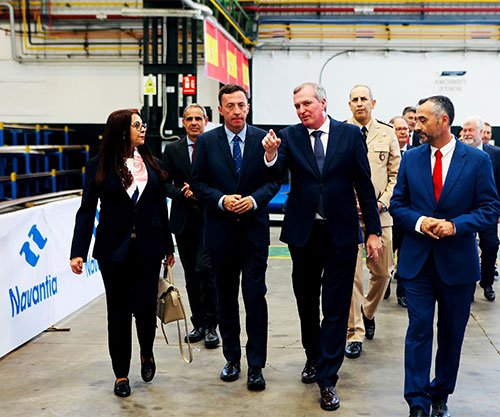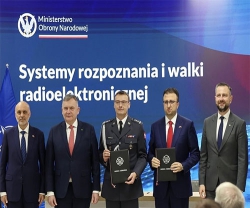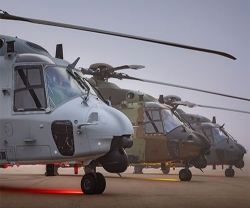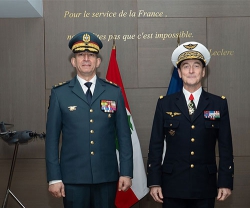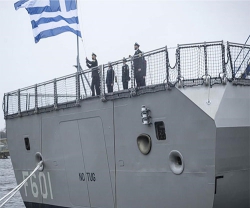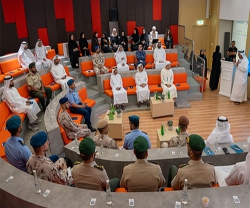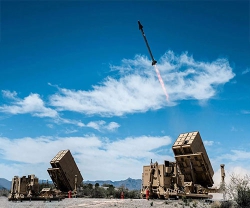Navantia shipyards of Puerto Real and San Fernando have started the production phase of a Maritime Action Ship for Underwater Intervention (BAM-IS) for the Spanish Navy and one Offshore Patrol Vessel (OPV) for the Royal Moroccan Navy.
In both cases, the maneuvers consisted of cutting the first plate of a pilot block to fine-tune the production systems. The construction of such blocks, belonging to the upper part of the engine room, will allow the new digital design, control and management tools implemented in the shipyard to be put into operation and tested. The BAM-IS will be the first ship built at the Puerto Real shipyard using such tools.
The BAM-IS, which will be named ‘Poseidon’, will be the specialized and equipped platform for salvage and submarine rescue support. Likewise, it will be the Spanish Navy's main unit for supporting diving operations, replacing the rescue and salvage vessel 'Neptune', and is expected to be ready in 2026.
The manufacture of the BAM-IS responds to a need associated with the S-80 submarines to provide support and guarantee the safety of the crews throughout their operational life.
The BAM-IS vessel is highly modular in nature. With its large working deck, more than 400 square meters, it enables the installation of different modular systems that allow it to be configured for different mission profiles: diving operations, submarine rescue or salvage, underwater heritage protection, etc. For this purpose, it also has an innovative propulsion and electrical generation plant, based on direct current technologies, energy storage systems and cycloidal thrusters, which provides it with the capacity to maintain a highly accurate dynamic positioning even in adverse weather conditions, all in compliance with the most demanding environmental standards.
In addition, this new unit for the Navy will be capable of operating with the NATO Submarine Rescue System “NSRS”. This quality, among others, will allow it to obtain for the first time for a Spanish Navy ship, the ‘MOSHIP’ certification to act as a mother ship for NATO submarine Rescue and Rescue systems. It will also be equipped with remotely operated vehicles (ROV) capable of remote underwater exploration and intervention.
On the other hand, at the San Fernando shipyard, identical maneuvers have been undertaken in the fabrication workshop to build an Offshore Patrol Vessel for the Royal Moroccan Navy.
The construction of this OPV for Morocco also includes a technical-logistical support package (spare parts, tools and technical documentation), including technical training services for the personnel of the Royal Moroccan Navy in Spain.
The OPV is a solution that guarantees long periods of deployment at sea, with very low operating and life-cycle costs. To achieve this, the design of its systems aims to maintain operability, maintainability, and reliability with a reduced crew.
With a history of more than 300 years linked to the construction of ships for the Navy, Navantia is a state-owned and strategic technology company for the defense of Spain. Its areas of specialization range from shipbuilding (surface and submarine), to the design and integration of systems with a high technological content and life cycle support and high value-added services.
Additionally, with its brand Navantia Seanergies, it is a global supplier for the development of offshore wind energy and other green energies such as hydrogen. Navantia employs nearly 4,000 people directly in Spain, mainly at its offices in Ferrol and Fene (A Coruña), Puerto, Real, San Fernando, Cádiz and Rota (Cádiz), Cartagena (Murcia Region) and Madrid.
Committed to building a safe and sustainable future through technological excellence and industrial collaboration, Navantia has contracts with Governments and companies around the world and ties with universities and technological and academic centers. It contributes to sustainability and innovation through its daily commitment to people and the planet, with responsible practices from the point of view of labour, the environment and economic and technological development that are viable regionally, nationally and internationally.
Navantia is owned 100% by the Sociedad Española de Participaciones Industriales (SEPI), attached to the Ministry of Finance and Public Function of Spain).

